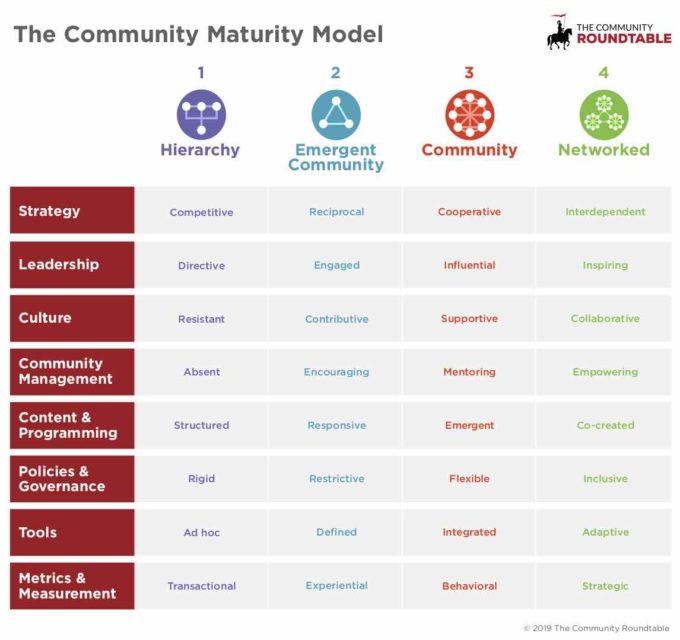When we originally developed the Community Maturity Model, we thought of it as a tool that organizations of all sizes could use in creating a baseline understanding of where they were on the path to becoming a ‘social’ organization. Additionally, it was designed to provide organizations with a general roadmap of the competencies and milestones needed to operationalize a social layer within their organization.
Recently we had a large corporate client take the Community Maturity Model and build out an organizational gap analysis using both the model and the best practice research that was published in The State of Community Management report. We’ve taken that work and created a template for our other members – giving them a huge jump start in creating a document that is easy to understand and communicate to other organizational stakeholders. In addition, we have created baseline assessment criteria to help organizations better understand where they fit on the model and identify the milestones and deliverables that are typically associated with the next stage of maturity. These criteria were developed based on our work with many companies and our understanding of the typical pathways to becoming a social organization.
In Stage 1/Hierarchy, where there is no organized initiative around social business, community management, or social media use it is easy to assess – there are no identifiable artifacts of an emergent community management discipline – no policies, no people responsible for it, no planning – although there may be a lot of ad hoc or informal use of social tools by employees.
Stage 2/Emergent Community defines an organization that is actively pursuing a social business strategy and has begun to lay the operational groundwork to support that, but has not yet realized full deployment and scale. Moving in to Stage 2/Emergent Community, there are standard indicators of organizational evolution, including:
- A documented active listening strategy
- One or more people explicitly responsible for social listening
- One or more social business leads have been identified
- There are some places where constituents (customers/partners/employees) can comment and/or contribute to a company sponsored conversations. (this might be a Twitter/Facebook/LinkedIn account, a blog, or a support forum)
- A centralized ‘social’ team has a documented roadmap and identified gaps
- Corporate accounts are established on the major social networking sites – Facebook, Twitter, LinkedIn, and YouTube.
- A basic listening toolset has been identified and is actively used
- Basic metrics – number of participants (members/fans/followers), pageviews, and number of comments – are tracked and reported to functional managers
The above indicators are those we feel are required elements to be in the Emergent Community stage, but there are additional elements that very likely exist in this stage as well, including a documented social media policy, and active social media presence, an executive sponsor, a dedicated social media or community manager, and an internal social software pilot – among many other possible initiatives that may exist in this early stage of maturity.
Are there early milestones that we missed that you feel are required elements for companies that are seriously pursuing a social business approach? We’d love to hear from you.
Find this interesting? We use the Community Maturity Model to organize content and programming in TheCR Network and to advise clients. Consider joining TheCR Network as a member to discuss this an many other topics with peers and industry experts.






